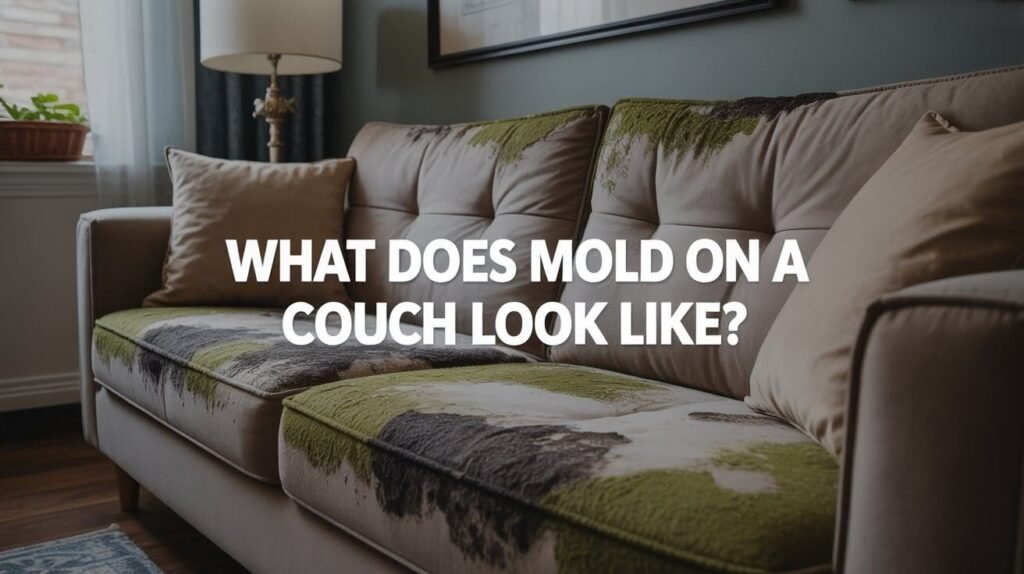Couch mold is a surprisingly common household issue that often goes unnoticed until it becomes a serious problem.
Many homeowners focus on visible areas like bathrooms and basements while overlooking their furniture, where mold can quietly establish itself in cushions, fabric, and hidden crevices.
The soft, porous materials in upholstered furniture create ideal conditions for mold growth, especially when exposed to moisture or humidity.
Identifying mold early is crucial for protecting both your family’s health and your furniture investment.
Mold exposure can trigger respiratory issues, allergies, and other health concerns, while prolonged growth can permanently damage expensive upholstery.
This comprehensive guide covers everything you need to know about couch mold: how to recognize its appearance, understand different types, identify common causes, and take immediate action steps to address the problem effectively.
How to Tell If Your Couch Has Mold
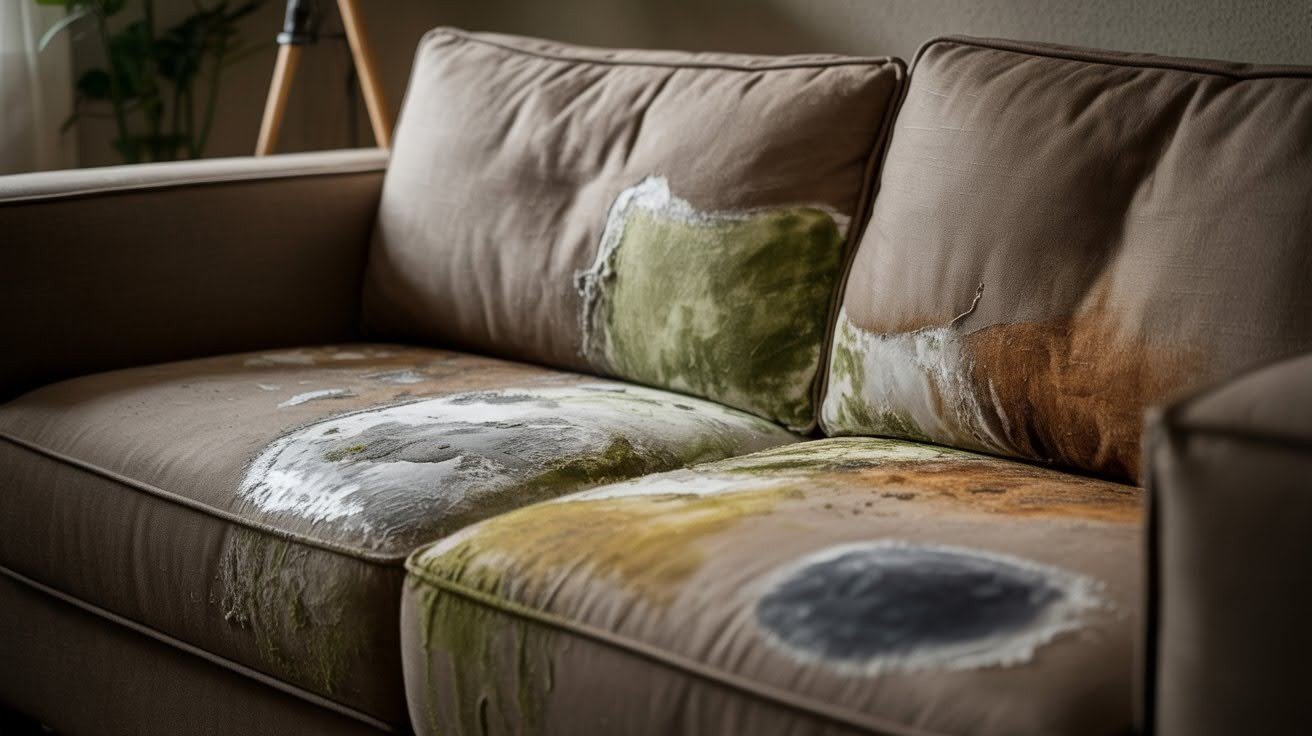
Identify couch mold through visual spots, musty odors, fabric discoloration, and damp textures to catch problems before they spread.
1. Look for Spots or Patches
Visual inspection is your first line of defense when checking for mold on furniture.
Mold typically appears as distinct spots or patches in various colors including white, green, black, gray, or brown, depending on the species and stage of growth.
These growths often have distinctive textures that range from fuzzy cotton-like appearances to dusty powdery surfaces, or even slimy wet patches in severe cases.
Pay close attention to seams, crevices, and areas where different materials meet, as these locations provide ideal hiding spots for mold colonies to establish and spread throughout your furniture.
2. Smell for Musty Odors
A persistent musty smell is one of the most reliable indicators of mold presence, even when visual signs aren’t immediately apparent.
Mold produces volatile organic compounds that create characteristic damp, earthy odors reminiscent of wet soil or rotting leaves.
These smells often become noticeably stronger when you sit on the couch, move cushions, or disturb the furniture in any way, as movement releases trapped spores and gases into the air.
If you notice these odors consistently, especially after the furniture has been cleaned, mold growth is likely occurring within the cushions or frame.
3. Check for Discoloration
Fabric discoloration often signals mold activity, appearing as yellow stains, black spots, or dark patches that seem to spread over time.
Water rings from spilled drinks, faded patches where moisture has damaged fabric dyes, and unusual color changes in upholstery all indicate moisture problems that can lead to mold growth.
Look carefully at areas that receive less light or air circulation, such as the back of cushions against walls, underneath armrests, and in corners where dust and moisture tend to accumulate and create favorable conditions for mold development.
4. Feel for Damp or Soft Areas
Physical texture changes in your couch fabric or cushions often reveal hidden mold problems.
Run your hands over the surface to check for unusual dampness, soft spots that feel different from the surrounding material, or areas where the fabric feels weakened or deteriorated.
Soggy cushions, spongy areas in the frame, or fabric that feels perpetually moist may indicate mold growth occurring within the furniture’s interior structure, where moisture has become trapped and created ideal breeding conditions for various mold species.
Where Mold Grows on a Couch
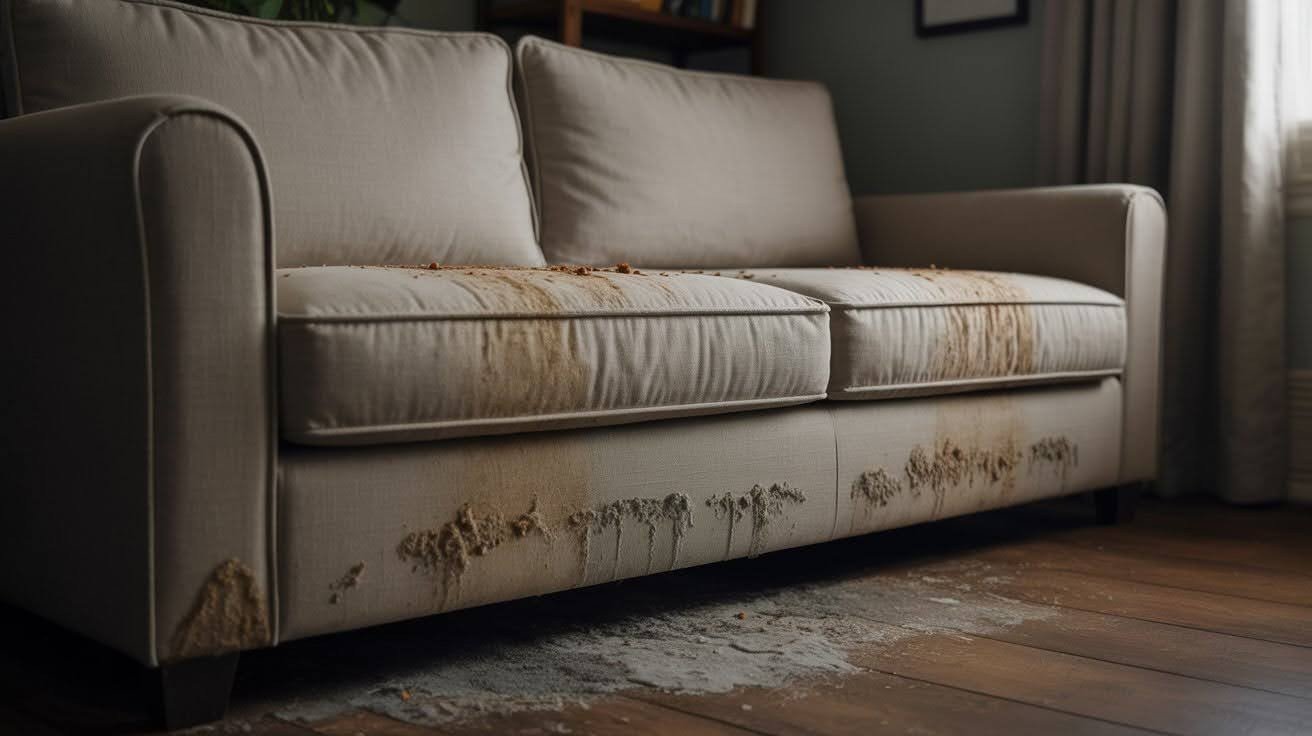
Common Places
- Under and between cushions – These spaces trap humidity from spills, body moisture, and condensation while receiving minimal airflow, creating perfect conditions for mold growth.
- On the back or bottom surfaces – Areas that sit against walls or floors with poor ventilation remain damp longer and lack direct sunlight exposure.
- Inside the frame or padding – Wooden frames absorb moisture while foam padding retains humidity, providing organic matter that feeds mold colonies in hard-to-detect locations.
- Around seams and crevices – Food crumbs, pet dander, and dust settle in these areas, providing additional nutrients that support mold development and spread.
- Near zippers and buttons – These hardware areas create small pockets where moisture can collect and remain trapped for extended periods.
- Against basement or exterior walls – Couches positioned near these surfaces experience higher humidity levels and condensation that promote mold establishment.
What Mold Looks Like on Different Couch Materials
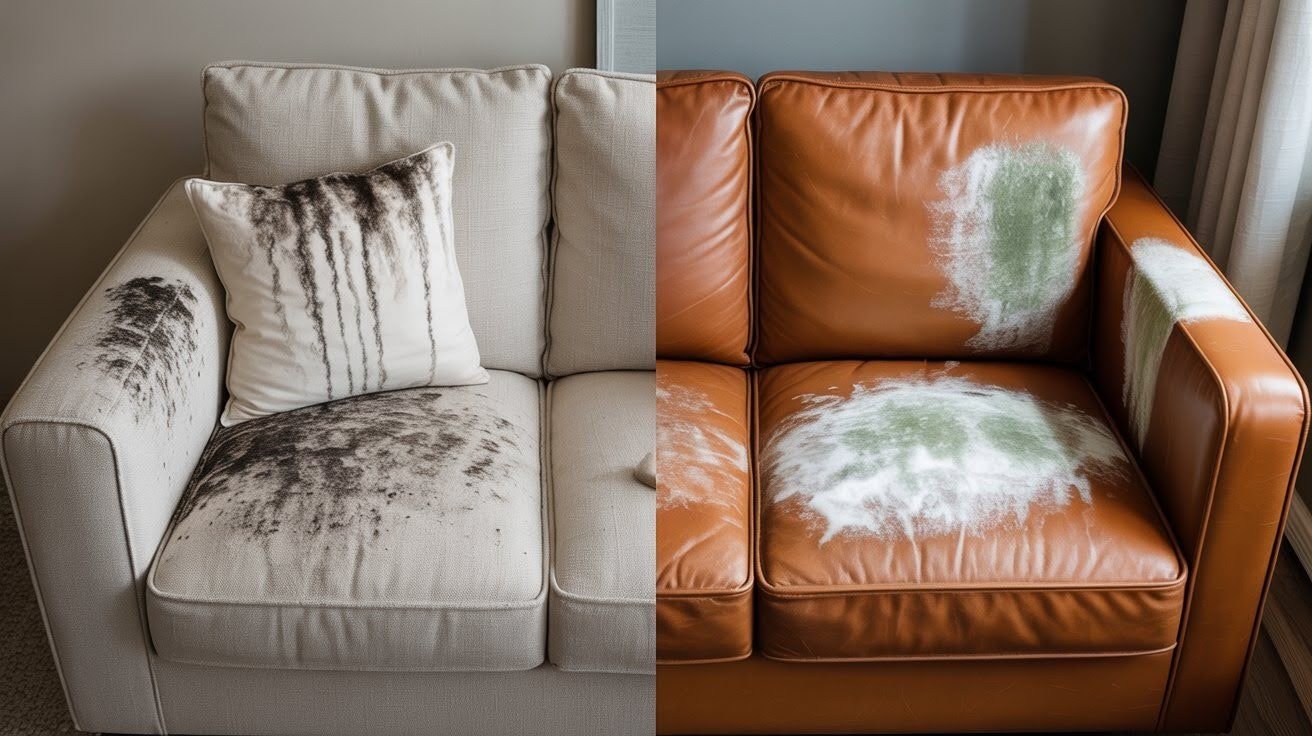
Mold appearance varies by material – fabric shows spots and fuzzy textures while leather develops patches with chalky or sticky surfaces.
Fabric Couches
Mold on fabric couches typically manifests as black or white spots that create distinct circular or irregular patterns against the upholstery surface.
These spots are usually easy to identify on light-colored fabrics due to their contrasting appearance, but they can blend with dark-colored materials, making detection more challenging.
The mold often develops a fuzzy or powdery texture that feels rough or dusty when touched, distinctly different from the original fabric texture.
As it spreads, mold follows the weave pattern of the fabric, creating streaky or thread-like growth patterns that extend outward from the initial infection point, gradually covering larger areas of the upholstery.
Leather Couches
On leather furniture, mold appears as green or white patches with defined edges that typically sit on the surface rather than penetrating deeply into the material.
White mold on leather often has a chalky appearance resembling powder or chalk dust that may initially wipe away but returns quickly if moisture conditions persist.
Advanced mold growth develops a sticky or slimy texture that feels unpleasant to touch, indicating significant moisture presence and well-established colonies.
Over time, mold can cause serious damage to leather, leading to cracking, brittleness, and permanent discoloration that compromises both the material’s appearance and structural integrity.
What Causes Mold on a Couch?
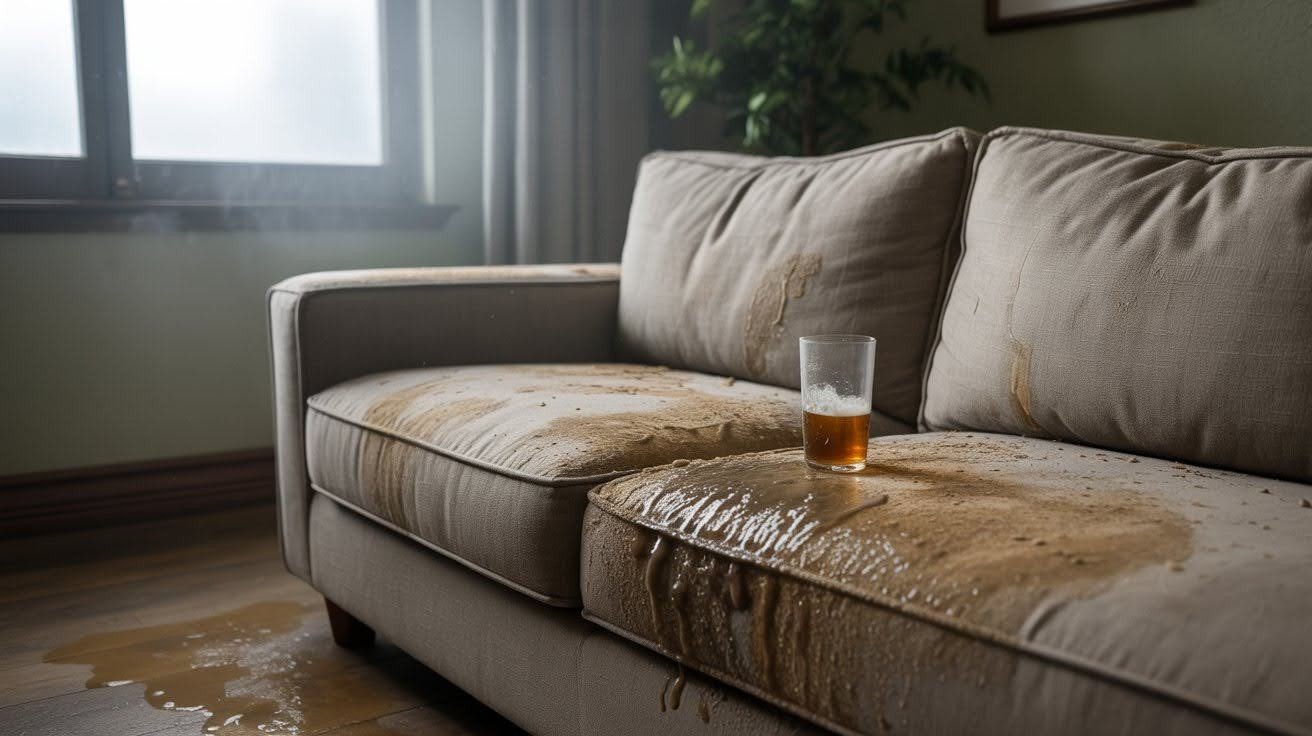
1. High Humidity
Mold thrives in warm, moist environments where humidity levels exceed 60%.
This problem is particularly common in rainy climates and coastal areas where indoor moisture remains consistently high.
Homes without proper dehumidification or ventilation systems create ideal conditions for mold spores to establish colonies on furniture surfaces and within cushioning materials.
2. Spills or Water Damage
Direct moisture from spilled drinks, pet accidents, or household leaks creates immediate mold risks if not dried quickly.
Even small amounts of liquid can penetrate deep into cushions and padding, where trapped moisture provides perfect breeding conditions.
Pet messes are especially problematic because they introduce both moisture and organic nutrients that accelerate growth.
3. Poor Airflow
Inadequate air circulation prevents moisture from evaporating naturally, creating stagnant conditions around furniture.
Couches positioned too close to walls or in corners without proper spacing trap humidity and condensation.
Rooms lacking ceiling fans, windows, or HVAC circulation allow any present moisture to remain against furniture surfaces for extended periods.
How to Prevent Mold on a Couch
- Keep humidity under control – Maintain indoor humidity levels between 30-50% using dehumidifiers or air conditioners, and monitor moisture with digital hygrometers.
- Clean up spills fast – Address liquid accidents immediately by blotting excess moisture and thoroughly drying affected areas with fans or hair dryers.
- Leave space around your couch – Position furniture at least 6 inches away from walls to allow proper airflow and prevent moisture buildup in tight spaces.
- Use fans or open windows for air circulation – Promote air exchange with ceiling fans, portable fans, or regular window opening to prevent stagnant conditions where mold thrives.
- Remove and wash cushion covers – Take off removable covers immediately after spills and ensure all components dry completely before reassembling the furniture.
- Address moisture sources – Control cooking steam, shower humidity, and basement dampness that contribute to overall indoor moisture levels throughout your home.
Conclusion
Mold on couches is a more common household issue than many people realize, but it’s entirely manageable when you know what to look for and how to respond.
The key to protecting your furniture and family’s health lies in early detection – regularly checking for visual signs like spots and discoloration, noticing musty odors, and feeling for damp areas can help you catch problems before they become serious.
Taking swift action when you spot mold signs prevents extensive damage and costly replacements.
However, prevention remains your best defense against couch mold.
By controlling humidity levels, cleaning spills immediately, ensuring proper air circulation, and maintaining adequate spacing around your furniture, you can create an environment where mold simply cannot establish itself.
With these simple practices, you can keep your couch fresh, clean, and mold-free for years to come.
Frequently Asked Questions
What color is mold on furniture?
Mold on couches appears in various colors including white, green, black, gray, and brown depending on the species and growth stage. The color often depends on the type of material and moisture conditions present in your furniture.
How can I tell if my couch smells like mold?
Mold produces a distinct musty, earthy odor that becomes stronger when you sit on or move the couch. This damp smell is often the first sign of mold presence, even before visible growth appears.
Where does mold typically grow on a couch?
Mold commonly develops under and between cushions, on the back and bottom surfaces, and inside the frame or padding. These hidden areas trap moisture and receive limited air circulation, creating ideal conditions for growth.
Does mold look different on fabric versus leather couches?
On fabric couches, mold appears as fuzzy or powdery spots that may blend with dark materials. On leather furniture, it shows up as chalky white or green patches that can feel sticky or slimy.
What does mold feel like on couch fabric?
Moldy areas often feel damp, soft, or unusually spongy compared to the surrounding material. The texture may seem rough, dusty, or deteriorated where mold has damaged the fabric fibers.


